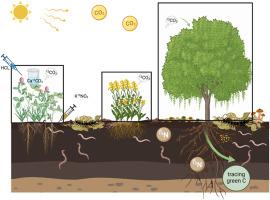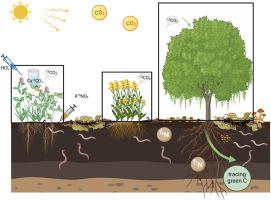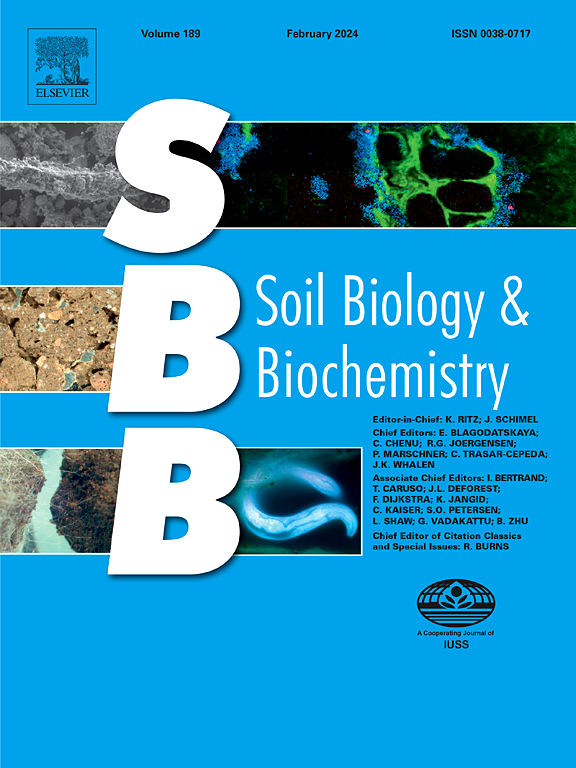种植系统和土壤动物生态群共同影响根系衍生的碳和矿质氮向土壤食物网的转移
IF 9.8
1区 农林科学
Q1 SOIL SCIENCE
引用次数: 0
摘要
根源碳(C)是为土壤食物网提供燃料的重要资源。然而,这些资源的数量随植物群落的不同而变化,也可能影响矿质氮(N)进入地下食物网的通量。然而,人们对不同植物群落(尤其是农业系统中的植物群落)如何影响土壤大型动物对植物碳和矿质氮的吸收知之甚少。在这里,我们将植物的脉冲 13C 标记与土壤的 15N 标记相结合,在作物单一栽培(油菜)、混合禾本科群落(禾本科与豆科植物的混合物)和幼树种植园(柳树)中追踪 28 天内根源 C 和矿质 N 分别进入作为主要土壤分解者和捕食者的蚯蚓和蜈蚣的通量。大量稳定同位素分析和氨基酸的特定化合物稳定同位素分析被用来量化土壤大型动物对 13C 和 15N 的吸收,并研究这些资源进入土壤大型动物体内的途径。表皮蚯蚓和无尾蚯蚓比内生蚯蚓吸收更多的根源性 C,这与它们使用植物资源的情况一致,内生蚯蚓主要依靠与土壤有机质相关的细菌或细菌新陈代谢产物。一般来说,大型动物在不同的种植系统中都能吸收根源碳和矿质氮,但在油菜和禾本科植物中的吸收比在柳树中更明显。重要的是,根源资源促进了土壤动物食物网中矿质氮的吸收。作为土壤中最重要的捕食者之一,蜈蚣主要通过捕食禾本科植物来吸收根源碳和矿质氮,而柳树中的表皮蚯蚓很可能也是它们的食物来源。总体而言,根源碳和矿质氮进入土壤食物网的通量取决于植物群落和土壤动物生态群,草本作物的通量高于树木种植园。本文章由计算机程序翻译,如有差异,请以英文原文为准。


Cropping systems and ecological groups of soil animals jointly affect the transfer of root-derived carbon and mineral nitrogen into the soil food web
Root-derived carbon (C) is a crucial resource fuelling soil food webs. However, the quantity of these resources varies with plant communities and may also influence the flux of mineral nitrogen (N) into belowground food webs. Yet, little is known about how different plant communities, especially in agricultural systems, influence the incorporation of plant C and mineral N into the soil macrofauna. Here, we combined pulse 13C-labelling of plants with 15N-labelling of soil in a crop monoculture (oilseed rape), a mixed grass community (grass and legume mixture) and a young tree plantation (willow) to trace the fluxes of root-derived C and mineral N into earthworms and centipedes as major soil decomposers and predators, respectively, over 28 days. Bulk stable isotope analysis and compound-specific stable isotope analysis of amino acids were used to quantify the uptake of 13C and 15N by soil macrofauna and to investigate the pathways by which these resources are channelled into soil macrofauna. Aligning with their use of plant-derived resources, epigeic and anecic earthworms incorporated more root-derived C than endogeic earthworms, with endogeic earthworms mainly relying on bacteria or bacterial necromass associated with soil organic matter. Generally, macrofauna incorporated both root-derived C and mineral N across cropping systems, but incorporation was more pronounced in rape and grass than in willow. Importantly, root-derived resources facilitated the incorporation of mineral N into soil animal food webs. Centipedes, as one of the most important predators in soil, mainly incorporated root-derived C and mineral N via preying on collembolans, whereas in willow epigeic earthworms likely also contributed to their diet. Overall, the fluxes of root-derived C and mineral N into the soil food web depended on plant communities and soil animal ecological groups, with higher fluxes in herbaceous crops than in tree plantations.
求助全文
通过发布文献求助,成功后即可免费获取论文全文。
去求助
来源期刊

Soil Biology & Biochemistry
农林科学-土壤科学
CiteScore
16.90
自引率
9.30%
发文量
312
审稿时长
49 days
期刊介绍:
Soil Biology & Biochemistry publishes original research articles of international significance focusing on biological processes in soil and their applications to soil and environmental quality. Major topics include the ecology and biochemical processes of soil organisms, their effects on the environment, and interactions with plants. The journal also welcomes state-of-the-art reviews and discussions on contemporary research in soil biology and biochemistry.
 求助内容:
求助内容: 应助结果提醒方式:
应助结果提醒方式:


